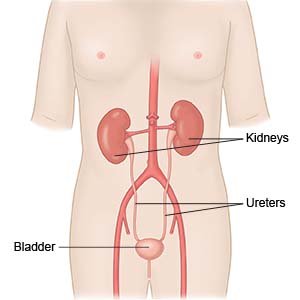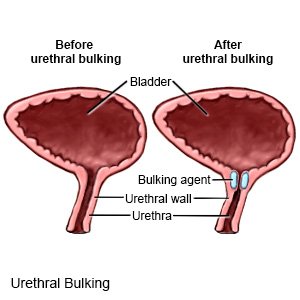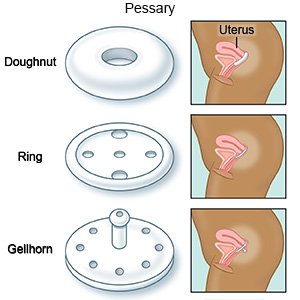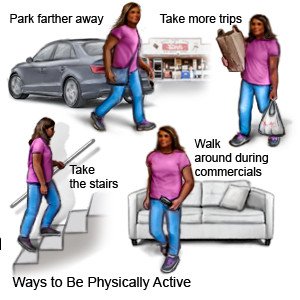Urinary Incontinence
Medically reviewed by Drugs.com. Last updated on Sep 23, 2025.
What is urinary incontinence (UI)?
UI is loss of bladder control. UI develops because your bladder cannot store or empty urine properly. The 3 most common types of UI are stress incontinence, urge incontinence, or both.
 |
What are the signs and symptoms of UI?
- You feel like your bladder does not empty completely when you urinate.
- You urinate often and need to urinate immediately.
- You leak urine when you sleep, or you wake up with the urge to urinate.
- You leak urine when you cough, sneeze, exercise, or laugh.
How is UI diagnosed?
Your healthcare provider will ask about your symptoms, medical history, and current medicines. Your provider will examine your pelvic area and abdomen to look for problems that may be causing your symptoms. Tell your provider how much liquid you drink each day. Any of the following may be used to confirm or rule out UI:
- Urine tests may show an infection or other problem causing your symptoms.
- A cystoscopy is a procedure to look inside your urethra and bladder with a cystoscope. A cystoscope is a small tube with a light and magnifying camera on the end. Your healthcare provider may also do a ureteroscopy during a cystoscopy. A ureteroscopy is a procedure to look inside your ureters and kidneys.
- Cystometry is used to check the function of your urinary system. The pressure in your bladder is measured while it is filled with fluid. Your bladder pressure may also be tested when your bladder is full and while you urinate.
- X-ray, ultrasound, or CT scan pictures may show problems with parts of your urinary system. You may be given contrast liquid to help your urinary system show up better in the pictures. Tell the healthcare provider if you have ever had an allergic reaction to contrast liquid. Do not enter the MRI room with anything metal. The MRI machine uses a powerful magnet. Metal can cause serious injury from the magnet. Tell the healthcare provider if you have any metal in or on your body.
Related medications
How is UI treated?
- Medicines can help strengthen your bladder control. You may need medicine to relax your bladder or to stop your bladder from contracting (squeezing) on its own.
- Electrical stimulation is used to send a small amount of electrical energy to your pelvic floor muscles. This helps control your bladder function. Electrodes may be placed outside your body or in your rectum or vagina.
- A bulking agent may be injected into the wall of your urethra to make it thicker. This helps keep your urethra closed and decreases urine leakage.

- Devices such as a clamp, pessary, or tampon may help stop urine leaks. Ask your healthcare provider for more information about these and other devices.

- Surgery may be needed if other treatments do not work. Several types of surgery can help improve your bladder control. Ask your provider for more information about the surgery you may need.
Treatment options
The following list of medications are related to or used in the treatment of this condition.
How can I manage my symptoms?
- Do pelvic muscle exercises often. Your pelvic muscles help you stop urinating. Squeeze these muscles tight for 5 seconds, then relax for 5 seconds. Gradually work up to squeezing for 10 seconds. Do 3 sets of 15 repetitions a day, or as directed. This will help strengthen your pelvic muscles and improve bladder control.
- Keep a UI record. Write down how often you leak urine and how much you leak. Make a note of what you were doing when you leaked urine.
- Train your bladder. Go to the bathroom at set times, such as every 2 hours, even if you do not feel the urge to go. You can also try to hold your urine. For example, hold your urine for 5 minutes when you feel the urge to go. As that becomes easier, hold your urine for 10 minutes. Behavior therapy may help you learn to control the urge to urinate.
- Drink liquids as directed. Ask your healthcare provider how much liquid to drink each day and which liquids are best for you. You may need to limit the amount of liquid you drink to help control your urine leakage. Do not drink any liquid right before you go to bed. Limit or do not have drinks that contain caffeine or alcohol.
- Prevent constipation. Eat a variety of high-fiber foods. Good examples are high-fiber cereals, beans, vegetables, and whole-grain breads. Prune juice may help make your bowel movement softer. Walking is the best way to trigger your intestines to have a bowel movement.

- Be physically active and maintain a healthy weight. Ask your healthcare provider what a healthy weight is for you. Extra weight puts pressure on your bladder and may make your symptoms worse. Your provider can help you create a weight loss plan, if needed. The plan will include ways to be physically active that will not put extra pressure on your bladder.

- Use a catheter as directed to help empty your bladder. A catheter is a tiny, plastic tube that is put into your bladder to drain your urine. Your provider may tell you to use a catheter to prevent your bladder from getting too full and leaking urine.
When should I seek immediate care?
- You have severe pain.
- You are confused or cannot think clearly.
- You see blood in your urine.
- You have pain when you urinate.
- You have new or worse pain, even after treatment.
When should I call my doctor?
- You have a fever.
- Your mouth feels dry or you have vision changes.
- Your urine is cloudy or smells bad.
- You have questions or concerns about your condition or care.
Care Agreement
You have the right to help plan your care. Learn about your health condition and how it may be treated. Discuss treatment options with your healthcare providers to decide what care you want to receive. You always have the right to refuse treatment. The above information is an educational aid only. It is not intended as medical advice for individual conditions or treatments. Talk to your doctor, nurse or pharmacist before following any medical regimen to see if it is safe and effective for you.© Copyright Merative 2025 Information is for End User's use only and may not be sold, redistributed or otherwise used for commercial purposes.
Learn more about Urinary Incontinence
Treatment options
Care guides
Symptoms and treatments
Medicine.com guides (external)
Further information
Always consult your healthcare provider to ensure the information displayed on this page applies to your personal circumstances.
